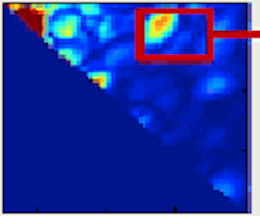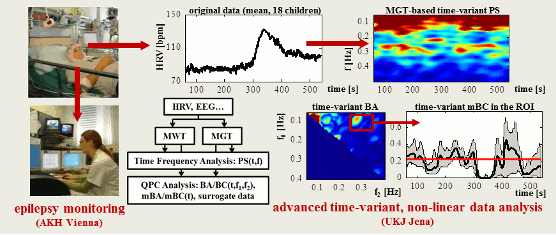Advanced time-variant and non-linear approaches can be beneficially used for analysis of biomedical signals and are able to gain new insights into specific signal characteristics like short term patterns in the heart rate variability (HRV) of epileptic children or in the electroencephalogram (EEG) of neonates during sleep.
Principle aim of this study is to investigate the performance of Matching Pursuit (MP)-based bispectral analysis in the detection and quantification of quadratic phase couplings (QPC). Nonlinear approaches such as time-variant bispectral analysis are able to provide information about phase relations between oscillatory signal components. Time-variant QPC analysis is commonly performed using Gabor transform (GT) or Morlet wavelet transform (MWT) and is affected by either constant or frequency-dependent time-frequency resolution (TFR). Matched Gabor Transform (MGT) emerging from the incorporation of GT into MP can overcome this obstacle by providing a complex time-frequency plane with an individually tailored TFR for each transient oscillatory component.
QPC analysis was performed by MGT, and compared to MWT (state-of-the-art method). Results were demonstrated using simulated data and biomedical benchmark data with a-priori knowledge about specific signal components. HRV of children during temporal lobe epilepsy and EEG during burst-interburst pattern of neonates during quiet sleep were used to investigate two main areas of biomedical signal analysis: cardiovascular-cardiorespiratory system and neurophysiological brain activities respectively.
Simulations were able to show the applicability and reliability of MGT for bispectral analysis. HRV and EEG analysis demonstrate the general validity of MGT for QPC detection by quantifying statistically significant time patterns of QPC. Results confirm that MGT-based bispectral analysis provides clear benefits for the analysis of QPC in biomedical signals, thereby revealing new and considerable insights, e.g. premonitory information regarding an imminent seizure or information on the mechanisms leading to changes of the autonomic nervous system for children with epilepsy.


